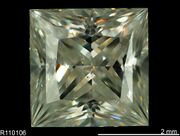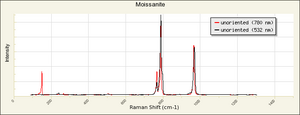Difference between revisions of "Moissanite"
| Line 18: | Line 18: | ||
* Luster = adamantine to metallic | * Luster = adamantine to metallic | ||
* Streak = greenish gray | * Streak = greenish gray | ||
| − | * Fluorescence = orange | + | * Fluorescence = inert to orange-red |
* Dispersion = 0.104 (extreme fire) | * Dispersion = 0.104 (extreme fire) | ||
Latest revision as of 13:48, 24 January 2023
Description
A rarely occurring natural mineral composed of Silicon carbide that was first discovered in rock samples from a meteor crater in 1893 by Henri Moissan. Synthetic silicon carbide was synthesized in the labs two years before the discovery of the natural mineral. Silicon carbide is resistant to thermal shock, thermal expansion, and high temperatures. The green to black powder is one of the hardest substances known to man and has been used as an abrasive for polishing glass, granite, and bisque ware. Synthetic moissanite has also been made as a jewel quality stone and was introduced in 1998 as a diamond alternative. Synthetic moissanite gemstones are optically similar to diamonds, but can be distinguished because of their thermochromism (change in color with gradual heating), electrical conductivity and birefringence.
Synonyms and Related Terms
silicon carbide; Siliziumcarbid (Deut.); carbure de silicium; siliciumcarbide (Ned.); kiselkarbid (Sven.); Forever One; Forever Brilliant; Forever Classic; Amora
Risks
- Noncombustible.
- Contact may cause mechanical irritation.
- Fisher Scientific: MSDS
Physical and Chemical Properties
- Cleavage = indistinct
- Fracture = conchoidal
- Luster = adamantine to metallic
- Streak = greenish gray
- Fluorescence = inert to orange-red
- Dispersion = 0.104 (extreme fire)
| Composition | SiC |
|---|---|
| Mohs Hardness | 9.25 |
| Density | 3.22-3.23 g/ml |
| Refractive index | 2.654 - 2.967 |
| Birefringence | 0.043 (strong doubling) |
Comparisons
Natural and Simulated Diamonds
Resources and Citations
- G.S.Brady, Materials Handbook, McGraw-Hill Book Co., New York, 1971 Comment: p. 713
- Gem Identification Lab Manual, Gemological Institute of America, 2016.
- The Merck Index, Martha Windholz (ed.), Merck Research Labs, Rahway NJ, 10th edition, 1983 Comment: entry 8636
- Encyclopedia Britannica, http://www.britannica.com Comment: silicon carbide" [Accessed July 26, 2002].
- Wikipedia: Moissanite (Accessed Dec 2022)

